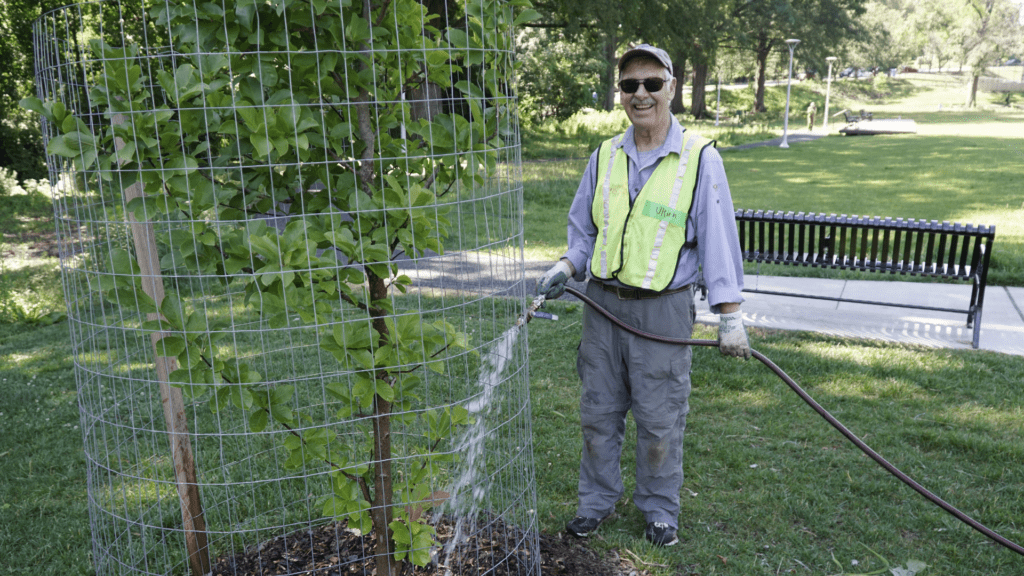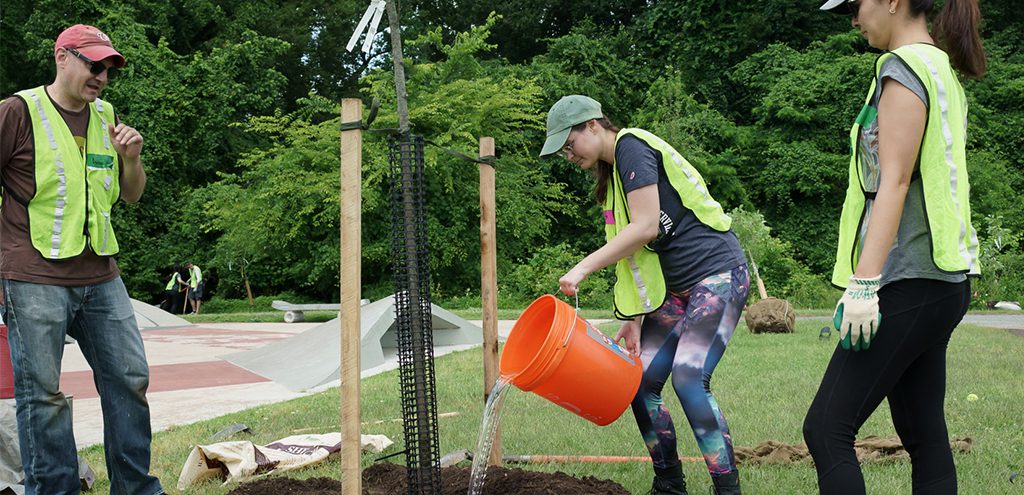Weekly Watering Alert | Must Water
The watering alert for June 9 – June 15, 2025, is Must Water. While the DC area is no longer experiencing a drought due to recent rainfall, there’s still less than an inch of rain predicted for this week, and temperatures are expected to soar into the 90s. Depending on actual rainfall amounts, trees will likely need more water this week!

Watering Alert Key:
Don’t Water – Recent or predicted rainfall exceeding 1.5 inches this week. Trees have enough water.
Optional – Trees may need water, depending on the forecast. Check trees for signs (wilting leaves and/or dry soil) and water as needed. See watering FAQs below for more guidance on how to water.
Must Water – Not enough rainfall is observed or forecasted this week. Young trees must be watered.
Watering alerts are determined using NOAA/National Weather Service’s observed and predicted precipitation amounts, drought monitoring, and local forecasts for the DC metro area. Watering alerts are updated every Monday evening and run April 1 through October 31.
Sign up for the Leaflet, or pledge to water trees, to receive our weekly watering alerts.
Watering FAQ
When should I water my trees?
Water early spring to late fall (April 1 – October 31). The best time of day to water is early morning or late evening. Watering during the day results in losing much of the water to evaporation.
Do I need to water my trees in winter?
In general, trees do not need to be watered in the winter. However, if a tree is planted in the winter, we do recommend watering initially to help establish the tree and settle the soil.
As fall turns to winter, you can stop watering trees that have lost their leaves, as the trees have gone dormant in anticipation of the winter months. Note that evergreen trees do not need water during the winter months, even though they keep their leaves. Resume watering trees in the spring when temperatures are regularly above 75 degrees.
How much water do my trees need?
Trees need approximately 10 gallons of water per inch of base trunk diameter, per week. Casey Trees often plants trees that are at least 1.50” in caliper (i.e. the trunk’s diameter is at least 1.5 inches), and thus require 15 gallons, up to 25 gallons of water (approximately 1.5 inches of rainfall), per week.
How should I water my trees?
The easiest way to water trees is to simply soak the roots with a garden hose for approximately 5 minutes a few times a week, when they need water. Directly water to the roots and base of the tree, not the leaves. You can also fill a five-gallon bucket and apply water to the base of the tree.


It is important to water slowly, especially when the ground is hard and dry. Water should soak into the soil – water will run off if too much is applied too quickly. If possible, place a hose a foot or so from the base of the tree and turn it on to a trickle. Let it run for 30 minutes (set a timer for yourself), occasionally moving the hose nozzle to provide water to the entire root zone of the tree. If you have a small sprinkler head, you can use that to cover a wider area – but again, turn it on low. You can also water with a five-gallon bucket that you have drilled some (five is sufficient) holes in the bottom about the diameter of a pencil lead. Place the bucket at the base of the tree, fill the bucket to the top with water, let it drain, move it slightly, and fill it again – up to five times.
Should I use a watering bag?
Slow-release watering bags can be helpful to aid in slow watering a tree. Casey Trees used to install watering bags with trees but stopped this practice for environmental reasons (less plastic use). It is possible to water trees sufficiently without watering bags. And while watering bags can be helpful, they can also damage a tree’s trunk if not adequately maintained or left on a tree to maturity. If you can thoroughly water your tree without the aid of a watering bag, we suggest that as the best practice.
Do mature trees need water?
While young trees (trees planted in the last 3 years) are most vulnerable, mature trees may also need help in periods of drought. Street trees may be especially susceptible. If you have street trees in front of your home, letting a hose drip onto their roots for a few hours will be a big help! Move the hose nozzle around every hour or so to water the entire area.
The root zone of a mature tree can be very large and extend far beyond the canopy of the tree. The critical root zone, where the majority of roots are located, can be calculated by multiplying the diameter of the tree by 3-5 times. Watering should be concentrated in this area and applied using a slow-release method.
Should I mulch around my trees?
Mulch keeps the water in the soil feeding the roots by slowing evaporation. Place a mulch ring around the tree following the 3-3-3 rule: create a ring of mulch around your tree, 3 inches deep in a 3-foot radius from the trunk, making sure to leave a 3-inch space right around the tree trunk. Remember to donut mulch, not volcano mulch – piling mulch against the trunk results in poor tree health.

Do some tree species need more water than others? Why?
The tree species we select and plant as urban trees have evolved in a variety of environmental conditions over time and can differ in their characteristics and needs. Some species adapted to wetter soil conditions near rivers or in low forest areas, like river birch or tulip poplar, and require more water to maintain proper plant function. Many oaks and pines have adapted to drier conditions and can tolerate lower soil moisture while maintaining their function. Leaf morphology, wood characteristics, and tree physiology can all be species-specific and influence the water needed for a tree species.
I am still unsure if my trees need water – what should I do?
The best way to ensure a young tree stays healthy after planting is to keep it well watered. When unsure, choosing to water is often the best choice. If you are still concerned, you can check soil moisture. Soil that is moist or damp to the touch is fine. If the soil feels dry, water the tree thoroughly. Water should soak into the soil. Trees should never sit in a puddle of water for an extended amount of time. This can lead to root damage.
Pledge to Water
"25 to Stay Alive" Watering Pledge